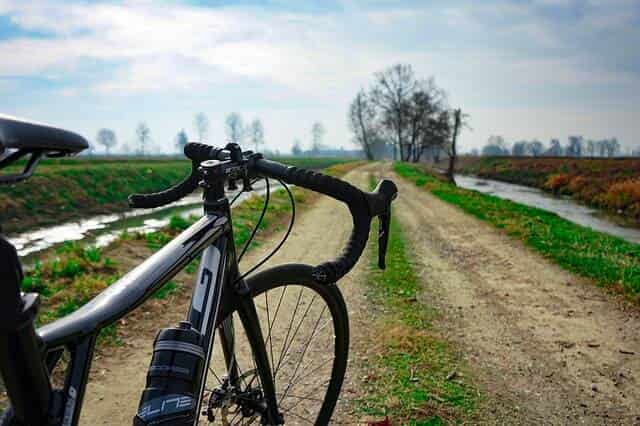So you’re looking for a bike, but you don’t want a one trick pony. Maybe your commute doesn’t consist of only roads, or your bike park has a few paved trails between the properly gnarly ones.
Whatever the case, a straight up road or mountain bike isn’t for you. You’re not looking for a dedicated tourer, or cruiser either. No, what you’re looking for is a hybrid bike…or a gravel bike. As it turns out, these two are often presented as interchangeable options. But, what should you ride?
The answer isn’t straight forward. Neither style of bike is objectively better than the other, but rather, they have different areas of strength.
In the case of gravel bikes, those strengths are pretty well defined. Hybrids are a bit more wide-ranging — which is a strength in itself.
In order to determine which bike is best for you, you’ll need to understand the pros and cons of each style, and any substantial differences between the two.
Let’s start by contrasting these two similar, but very different, bike classes.
Gravel Bike vs Hybrids: Which is The Right Bike For You?
Gravel and hybrid bikes are often touted as being good for all types of casual riding. Whether commuting, touring, or just riding for fun, you could be forgiven for believing that there is no appreciable difference between the two bike types.
However, there are a few things that could grant one bike an edge.
For instance, the straight bars and narrower tires make a hybrid better for the shorter distance, road-centric riding style most associated with commuting.
When it comes to the long distances and heavier loads that define touring, a gravel bike has the advantage.
Its drop bars allow for switching grip and position over the long haul, while its long wheelbase better distributes the weight of your provisions.
When it comes to leisure riding, neither bike has an objective advantage. Both styles are versatile enough to meet the less strenuous demands of riding for fun.
But, regardless of the type of riding you intend to do, your personal preferences and needs will help determine which bike is most suitable for you.

What is a Gravel Bike?
A gravel bike can be best characterized by its ability to comfortably transition from paved to moderate off-road conditions while maintaining its speed, handling, and comfort.
It isn’t built to take the punishment of a mountain bike, nor is it optimized for riding purely on paved terrain like a road bike. Gravel bikes gained recognition as an official class of bikes relatively recently.
The first production model was released under the Salsa brand in 2012 and was called the Warbird.
Prior to that, cyclists who outfitted their touring and road bikes with fatter tires and disc brakes to handle rough terrain existed, but their homebrew bikes had no name.
Since the introduction of the category, gravel bikes have seen wide adoption. Riders looking for a drop bar steed, able to eat up the miles whether smooth or rocky, are well served by these adventure bikes.
Advantages & Features
The primary advantage of the gravel bike is, as its name suggests, it’s ability to take on rough terrain. Other drop bar bikes tend to sport thin, smooth tires, and leaner frames.
Such features are optimal for long trips on level asphalt but become liabilities as soon as there’s a bump in the road. Gravel bikes have wider, knobby tires, with traction similar to that of a mountain bike.
Their frames are sturdier than your typical roadie or tourer, while the overall geometry is more relaxed than a more competition-focused off-roader.
This yields a ride that does not sacrifice control when leaving the pavement and can be ridden over inconsistent ground and elevations, for long distances, without discomfort.
The choice of drop-style handlebars grants gravel bikes all the accompanying pluses: the ability to position for greater speed, a narrower profile for maneuvering between obstacles, and versatility of positioning allowing rider combat aches on long rides.
Recomended: Diamondback Haanjo Carbon Gravel Adventure Bike ( Amazon Link )

What is a Hybrid Bike?
Oddly, the defining feature of a hybrid bike may well be that it doesn’t have a defining feature. Instead, it is a blend of road, mountain, and other bikes, with a bit more of the road bike DNA overall.
Hybrids provide solid, middle-range performance, and consistent comfort, in a variety of casual biking circumstances.
Like gravel bikes, hybrids existed in different forms before gaining their contemporary identity. However, hybrids have a longer history, as cyclists have tried to design a bike that can do it all since the 1800s.
In general, this type of bike has the frame and tires of a road bike, with the flat handlebars of a mountain bike. Commuter, trekking, city, and comfort bikes are all types of hybrids, tweaked a bit more in one direction than the other.
Advantages & Features
The biggest advantage of a hybrid is its versatility. It is the cycling world’s “Jack of all trades,” especially capable on the road, but able to handle light off roading, commuting, and even touring.
Hybrids generally have frames similar to those of a road bike. They are light, for easy overall handling.
The straight handlebars are a mountain bike feature, which gives greater leverage when steering and promotes upright riding posture.
Their tires tend to be skinnier than those of a gravel bike, but this is not always the case.
Hybrids can utilize rim brakes, which help to keep the weight down while providing ample stopping power for the intended types of riding.
They can also forgo gear options, further shedding weight with a less complex drivetrain.
Hybrids provide a comfortable ride in the widest variety of situations. They represent a compromise, trading specialization for utility. This is what makes them viable bikes for most cyclists.
Recomended: Diamondback Trace Dual Sport Hybrid Bicycle ( Amazon Link )
6 Key Difference Between Gravel Bike & Hybrid
Geometry
Comparing the geometry of gravel and hybrid bikes can be tricky. Gravel bikes are fairly consistent in design, but a broad range of bikes are considered to be hybrids.
Some elements of their different geometries are predictable, however. Hybrid bikes have the more relaxed geometry of the two.
They have shorter reach which, paired with the low bottom bracket, keeps the rider upright. Their straight bars and shorter wheelbase make for better tight cornering on paved surfaces.
Gravel bikes share the lower bottom bracket, but not the short reach. They have drop bars, calling for a more aggressive positioning — though they are still more relaxed than most road bikes.
They also have a longer wheelbase, granting greater stability when off-road.

Handlebars
The difference in handlebars can be the deciding factor between these bike styles. Whether you are in the drop bar or straight bar camp, there are some indisputable advantages and disadvantages for either choice.
Gravel bikes have drop bars, which are the preferred type when it comes to long-range riding, and high-speed riding. Drop bars allow a more aerodynamic, forward-leaning riding position.
They can also be gripped several different ways, so a rider doesn’t cramp up their back or hands having them locked in place over a long ride.
Hybrid bikes have straight bars, which are excellent for easy steering. The grip is further from the steering bar, granting more leverage for easy turning — and sharp cornering.
The wide-armed, upright seating position is much easier on the back as well.
Price – Gravel Bike vs Hybrids
Prices for gravel and hybrid bikes vary widely. As with any other style of bike, there are high end and budget models available.
However, at most price points before the top tier, gravel bikes tend to be more expensive.
This is because gravel bikes are more specialized than hybrids. They have to achieve greater performance on difficult terrain, which requires sturdier, pricier components.
By contrast, hybrid bikes can count very simple, and thereby cheaper, models among their number. There are fixie hybrids, for instance, which eschew many components that gravel bikes could never go without.
These price differences shrink drastically among high-end offerings.
At that level, both gravel and hybrid bikes utilize expensive frame materials like carbon fiber and titanium, and top-of-the-line components that cost the same regardless of bike style.
Stability & Control
The difference in stability and control in certain settings provides the primary contrast between these bike types.
The gravel bike controls better off road than the hybrid. This is essentially the purpose of the design, to elevate road bikes to capable off roaders.
This is done by way of the geometry and the tires, and allows excellent handling in the rough.
Hybrid bikes, while providing more of an MTB profile due to their straight bars, often outdo gravel bikes when it comes to handling on paved surfaces.
Those handlebars also grant them superior maneuvering control.
Because hybrids have so many variants, it is possible to find models that approach gravel bike handling offroad. However, if that is what you’re after, a gravel bike would be the better choice, to begin with.
Speed & Gearing
Gravel bikes must have multiple gear settings to be effective. You can expect to find them in the 8-12 gear range, with gear ratios starting lower to help with powering up ascents.
When choosing between single and double chain variants, single has the advantage.
A 1x is less likely to drop during especially demanding rides and removes the front derailleur for easier maintenance and lower weight.
Hybrid bikes can have gearing that runs the gamut from single gear up to 12 and beyond. The gearing helps to signal just how versatile you can expect a particular hybrid to be.
In terms of speed, the gravel bike’s more aggressive geometry and rider posture, paired with the certainty of helpful gear settings, can often lead to greater top speeds overall.
Gravel bikes are much faster off-road than hybrids, but, with similar gear settings, they are comparable on flat terrain.

Performance as Tour Bikes
To go touring is to ride far. Even the shortest trips that qualify as tours are dozens of miles in length.
A good touring bike is not only comfortable to ride for long stretches, but it also needs to be flexible enough to meet the challenges of varied terrain, and sturdy enough to carry your panniers filled with food and clothing.
Gravel bikes are excellent tourers. They are well designed for staving off the aches associated with lengthy rides, even off road.
Many models can be fitted to hold rear racks and panniers, and their low geometry means they are stable when heavily loaded.
Having a generous gear selection means they can be adjusted on the go to keep your cadence in the comfort zone. Some hybrid bikes make for great tourers as well, particularly if the route has shorter, lighter off-road portions — or none.
In the case of hybrids, though, be sure to pick a bike with these options. The hybrid designation doesn’t guarantee these features.
Which Bike is Easier To Maintain & Use?
Hybrid bikes will often have the advantage over gravel bikes when it comes to ease of care and use. The most extreme example of this would be a fixie hybrid with pedal braking. Such a bike consists of only the bare essentials, is unlikely to malfunction, and can be simply repaired in most cases.
However, the more common hybrids are likely to have a gear system, and rim or disc brakes.
Rim brakes are easier to service but more likely to malfunction. Gravel bikes are more likely to have disc brakes, which are difficult to service on your own.
The gear system itself is no more complicated on a hybrid bike than a gravel bike.
Maintenance on similar builds will be comparable. As for ease of use, it depends. For a new rider, either bike is just as easy to get the hang of.
However, if you are used to riding road bikes, the design of the gravel bike will feel more familiar, while MTB riders will initially take to the hybrid more. This is mainly due to the handlebars and geometry.
Final Words – Gravel Bike vs Hybrid
Gravel and hybrid bikes are both mash-ups of different specialized features, but the results are not quite the same.
A gravel bike feels like a road bike given the power to break free of the road. It can go the distance on all but the most technical terrain, and switch between them with ease.
Meanwhile, a hybrid can have seemingly endless identities, depending on the build. It’s the type of bike that is more tuned to the individual, rather than any specific type of riding.
Yet, either bike could be right for you, depending on your specific needs.
Also Read,
The Ultimate List of Best Gravel Bikes 2022 | Off-Road Ride
Gravel Bikes vs Mountain Bike – What Should You Ride?
Gravel Bike vs Road Bike: What’s the Difference?
Are Hybrid Bikes Better Than Mountain Bikes? | Find Your Perfect Bike









Leave a Reply